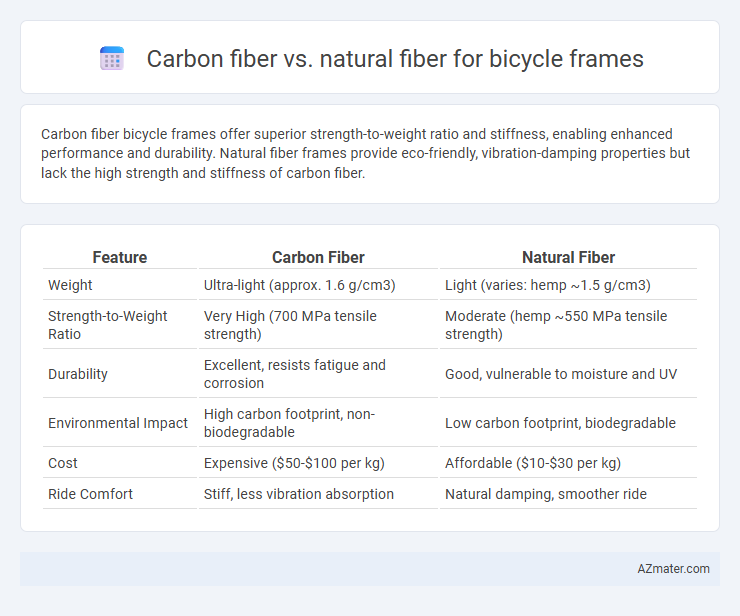Carbon fiber bicycle frames offer superior strength-to-weight ratio and stiffness, enabling enhanced performance and durability. Natural fiber frames provide eco-friendly, vibration-damping properties but lack the high strength and stiffness of carbon fiber.
Table of Comparison
| Feature | Carbon Fiber | Natural Fiber |
|---|---|---|
| Weight | Ultra-light (approx. 1.6 g/cm3) | Light (varies: hemp ~1.5 g/cm3) |
| Strength-to-Weight Ratio | Very High (700 MPa tensile strength) | Moderate (hemp ~550 MPa tensile strength) |
| Durability | Excellent, resists fatigue and corrosion | Good, vulnerable to moisture and UV |
| Environmental Impact | High carbon footprint, non-biodegradable | Low carbon footprint, biodegradable |
| Cost | Expensive ($50-$100 per kg) | Affordable ($10-$30 per kg) |
| Ride Comfort | Stiff, less vibration absorption | Natural damping, smoother ride |
Introduction to Bicycle Frame Materials
Carbon fiber offers exceptional strength-to-weight ratio and stiffness, making it a top choice for high-performance bicycle frames. Natural fibers such as flax, hemp, and bamboo provide eco-friendly alternatives with good vibration damping and moderate strength, appealing to sustainable cycling enthusiasts. The selection between carbon fiber and natural fiber frames involves balancing performance characteristics with environmental impact and durability.
Overview of Carbon Fiber Frames
Carbon fiber frames dominate the high-performance bicycle market due to their superior strength-to-weight ratio and excellent stiffness, offering enhanced speed and agility. The composite material allows precise engineering for optimal shock absorption and aerodynamic design, reducing rider fatigue and improving efficiency. Despite a higher cost and potential fragility compared to natural fiber alternatives, carbon fiber remains the preferred choice for competitive cycling and advanced recreational use.
Overview of Natural Fiber Frames
Natural fiber bicycle frames, typically made from materials such as flax, hemp, or bamboo, offer a sustainable and eco-friendly alternative to traditional carbon fiber frames. These fibers provide excellent vibration damping and shock absorption, resulting in a comfortable and smooth ride, although they usually have lower stiffness and strength-to-weight ratios compared to carbon fiber. Advances in composite technology have improved the durability and weight of natural fiber frames, making them increasingly popular among environmentally conscious cyclists seeking lightweight performance with reduced environmental impact.
Strength and Durability Comparison
Carbon fiber bicycle frames offer superior strength-to-weight ratios and exceptional stiffness, providing enhanced performance and responsiveness for demanding cyclists. Natural fiber frames, such as those made from bamboo or flax, exhibit good impact resistance and flexibility but generally lack the high tensile strength and fatigue resistance found in carbon composites. While carbon fiber ensures long-term durability under rigorous use, natural fiber frames offer sustainable alternatives with moderate strength and may require more maintenance to prevent degradation over time.
Weight Differences and Impact on Performance
Carbon fiber bicycle frames typically weigh between 700 to 1,200 grams, substantially lighter than natural fiber frames such as hemp or flax composites, which usually range from 1,200 to 1,600 grams. The reduced weight of carbon fiber enhances acceleration, climbing efficiency, and overall speed, offering a high strength-to-weight ratio critical for competitive cycling. Conversely, natural fibers provide better vibration damping and environmental benefits but generally result in heavier frames that may slightly compromise peak performance metrics.
Ride Quality and Vibration Dampening
Carbon fiber bicycle frames deliver superior ride quality with excellent stiffness-to-weight ratio, providing responsive handling and efficient power transfer while minimizing fatigue through advanced vibration dampening properties. Natural fiber frames, such as those made from flax or hemp, offer a more compliant and comfortable ride by naturally absorbing road vibrations due to their intrinsic damping characteristics, though they generally lack the rigidity and performance precision of carbon fiber. Riders seeking lightweight performance prioritize carbon fiber for its unmatched strength and vibration control, whereas those valuing environmental sustainability and comfort may prefer natural fibers despite modest trade-offs in stiffness and durability.
Environmental Impact and Sustainability
Carbon fiber bicycle frames offer superior strength and lightweight properties but have a high environmental impact due to energy-intensive manufacturing processes and difficulties in recycling. Natural fiber frames, often made from hemp, flax, or bamboo, provide a more sustainable alternative by using renewable resources and biodegradable materials, resulting in a lower carbon footprint throughout their life cycle. Despite slightly lower performance metrics, natural fiber frames significantly reduce waste and contribute to eco-friendly cycling solutions.
Cost and Accessibility
Carbon fiber bicycle frames typically cost between $1,000 and $5,000 due to expensive manufacturing processes and raw materials, making them less accessible for budget-conscious riders. Natural fiber frames, often made from materials like bamboo or flax, are generally priced between $300 and $1,200, offering a more affordable and eco-friendly alternative. Accessibility for natural fiber frames is higher in regions with abundant raw materials and artisanal production, while carbon fiber frames dominate commercial markets with advanced technology and widespread availability in high-performance cycling.
Customization and Design Flexibility
Carbon fiber offers superior customization and design flexibility for bicycle frames due to its ability to be molded into complex shapes and varied thicknesses, allowing precise tuning of stiffness and weight distribution. Natural fibers, such as flax or hemp, provide moderate customization with limited molding capabilities and typically result in bulkier frames that prioritize sustainability over intricate design. The advanced manufacturing techniques for carbon fiber enable lightweight, aerodynamic frames tailored to rider-specific performance demands, whereas natural fiber composites excel in eco-friendly aesthetics and vibration damping but lack fine-tuned structural versatility.
Future Trends in Bicycle Frame Materials
Carbon fiber remains dominant for high-performance bicycle frames due to its superior strength-to-weight ratio and stiffness, but future trends indicate an increasing shift towards sustainable materials like natural fibers, including flax and hemp composites. Advances in bio-based resins and hybrid fiber technologies are enhancing the durability and environmental benefits of natural fiber frames, making them more competitive in terms of weight and performance. Emerging manufacturing techniques, such as additive manufacturing and improved fiber-matrix bonding, are expected to accelerate the adoption of eco-friendly bicycle frames while meeting rigorous performance standards.

Infographic: Carbon fiber vs Natural fiber for Bicycle frame
 azmater.com
azmater.com